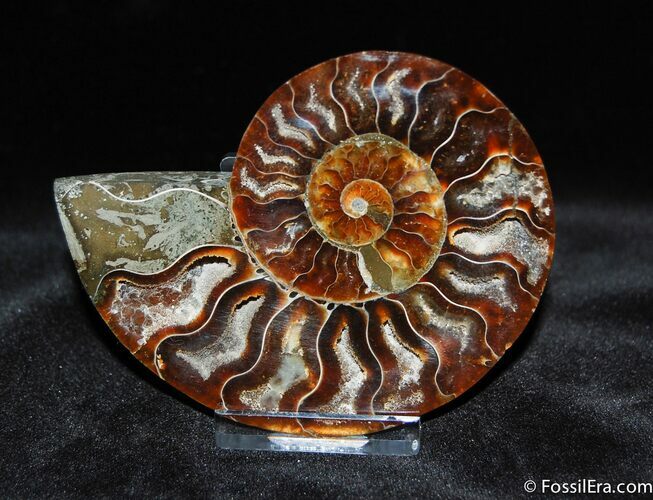This Specimen has been sold.
Beautiful 3.5 Inch Dark Color Split Ammonite (Half)
Here is a jaw dropping Cleoniceras ammonite from Madagascar which has been cut in half and polished to reveal all of the inner detail. Found in Madagascar, it lived in the shallow seas during the Middle Cretaceous Period, approximately 110 million years ago. This specimen is simply beautiful with both agatized and calcite crystal lined cavities. The polished back side displays some of this ammonites oak leaf shaped sutures.
It 3.5 inches wide and displays wonderfully on the included stand.
It 3.5 inches wide and displays wonderfully on the included stand.
About Ammonites
Ammonites were predatory, marine mollusks that thrived during the Paleozoic and Mesozoic eras, particularly in the Jurassic and Cretaceous periods, before going extinct around 66 million years ago. These creatures are characterized by their coiled, spiral shells, which resemble the modern-day nautilus. Ammonite shells were divided into chambers; as they grew, they built new chambers and sealed off the old ones. These chambers were filled with gas, which helped them control buoyancy in the ocean.
The outer shell of ammonites often displays intricate ribbed or ridged patterns and their fossils sometimes show a wide range of beautiful colors due to mineralization over time. The shells fossilized well, making ammonites abundant in the fossil record.. In addition to being popular in fossil collections, ammonites are valuable in geological studies, as they serve as index fossils, helping scientists date rock layers and understand the Earth's prehistoric environments.
Ammonites were predatory, marine mollusks that thrived during the Paleozoic and Mesozoic eras, particularly in the Jurassic and Cretaceous periods, before going extinct around 66 million years ago. These creatures are characterized by their coiled, spiral shells, which resemble the modern-day nautilus. Ammonite shells were divided into chambers; as they grew, they built new chambers and sealed off the old ones. These chambers were filled with gas, which helped them control buoyancy in the ocean.
The outer shell of ammonites often displays intricate ribbed or ridged patterns and their fossils sometimes show a wide range of beautiful colors due to mineralization over time. The shells fossilized well, making ammonites abundant in the fossil record.. In addition to being popular in fossil collections, ammonites are valuable in geological studies, as they serve as index fossils, helping scientists date rock layers and understand the Earth's prehistoric environments.
SPECIES
Cleoniceras
LOCATION
Ambatolafia, Mahajanga Province, Madagascar
FORMATION
N/A
SIZE
3.5"
CATEGORY
SUB CATEGORY
ITEM
#369
We guarantee the authenticity of all of our specimens.
 Reviews
Reviews













